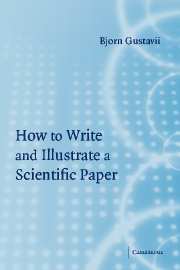Book contents
- Frontmatter
- Contents
- Preface
- Acknowledgments
- 1 Basic rules of writing
- 2 Comments on scientific language
- 3 Drafting the manuscript
- 4 Choosing a journal
- 5 Preparing a graph
- 6 How to design tables
- 7 Title
- 8 Authors
- 9 Abstract
- 10 Introduction
- 11 Methods
- 12 Results
- 13 Discussion
- 14 Acknowledgments
- 15 References
- 16 Numbers
- 17 Abbreviations
- 18 Common statistical errors
- 19 Typing
- 20 The covering letter
- 21 Dealing with editors and referees
- 22 Correcting proofs
- 23 Authors' responsibilities
- Literature needed on your desk
- Further reading
- Literature cited
- Index
4 - Choosing a journal
Published online by Cambridge University Press: 05 June 2012
- Frontmatter
- Contents
- Preface
- Acknowledgments
- 1 Basic rules of writing
- 2 Comments on scientific language
- 3 Drafting the manuscript
- 4 Choosing a journal
- 5 Preparing a graph
- 6 How to design tables
- 7 Title
- 8 Authors
- 9 Abstract
- 10 Introduction
- 11 Methods
- 12 Results
- 13 Discussion
- 14 Acknowledgments
- 15 References
- 16 Numbers
- 17 Abbreviations
- 18 Common statistical errors
- 19 Typing
- 20 The covering letter
- 21 Dealing with editors and referees
- 22 Correcting proofs
- 23 Authors' responsibilities
- Literature needed on your desk
- Further reading
- Literature cited
- Index
Summary
You will most probably find the right journal for your paper among those periodicals you most often read. That is where you have your readership.
If you think that more than one journal seems appropriate, you may wish to rank them by quality. One way to do so is to look at the “impact factor,” which tells how often the average article of a journal is cited. Such information is provided by the Institute for Scientific Information in its annual Journal Citation Reports.
The impact factor is especially useful for comparing journals within a particular field of research. Let us take, for example, Orthopedics. The 42 journals listed for 1998 had an impact factor in the range 0.2 to 2.1, with a median of 0.6. It is reasonable to assume that journals with an impact factor of 2.1 attract the best papers in the field, and that these journals have a greater impact on science in that field than a median (0.6) impact-factor journal.
However, if you select a high-impact journal, the publication of your paper may be delayed, as is hinted at in this question from a course participant:
Should I send my paper to a journal with a high impact factor and risk having it rejected, or should I send it to a journal with a lower impact factor and get it published quicker?
- Type
- Chapter
- Information
- How to Write and Illustrate a Scientific Paper , pp. 16 - 17Publisher: Cambridge University PressPrint publication year: 2003



